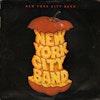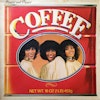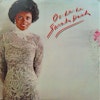Decades back, when state-of-the-art recordings could only be made in fancy studios that weren’t on your computer, a lot of ingredients went into making a song. In those days, constructing a track was an experience that required working with others, including session musicians and singers. Whether wailing, whispering, or sounding heavenly, singer Luther Vandross was one of the premier recording angels in the mid- to late ’70s and early ’80s in New York City who worked constantly as a background singer, contributing his own special something on microphones in sound factories (Atlantic Studios, the Hit Factory, Power Station, et al.) throughout Manhattan. Not only could he sing, Vandross was also a skilled vocal arranger who often helped guide the other singers through a track.
In 1974, Vandross’s status was elevated when he was hired by David Bowie to apply his vocal-booth expertise to the Young Americans project, an album inspired by the soul and disco music coming out of Philadelphia and New York City. After the Bowie album, featuring hit singles “Fame” and the title track, was released in March 1975, Vandross became even more in-demand. Be it a disco song, a commercial jingle, or a folk number, Vandross was the man with something special. By the end of the decade, his résumé included sessions with Bette Midler, Judy Collins, Roberta Flack, and Chic. “He stole the show,” producer Arif Mardin remembered in Luther: The Life and Longing of Luther Vandross by Craig Seymour. “This incredible sound—velvety, warm—came out of the man. The voice left an imprint on the studio session scene.”
The jingles Vandross recorded also paid very well. “Jingles paid the bills and kept Luther living in fine style,” Seymour wrote. “His apartment was lavishly decorated in his favorite color, pink. ‘I don’t think I could remember them all if I tried,’ he said. ‘[There was] Kentucky Fried Chicken, Miller Beer, that AT&T “Reach Out and Touch Someone” commercial.’ He also pitched for Revlon, Bell Telephone, Burger King, Schaeffer Beer, Mountain Dew, and Steak and Ale restaurants. He told folks that NBC-TV was ‘proud as a peacock,’ that ‘there’s nothing like the flavor of Juicy Fruit gum,’ and ‘when it’s time to relax, Miller stands clear…Miller Beer.’”
In 1979, producer Alan Douglas, best known for his work with Jimi Hendrix and the Last Poets, was contacted by American International Recordings. The music side of B-movie titans American International Pictures, the company released soundtracks for their own productions and wanted Douglas to put together a studio band to create the music for Sunnyside, a really bad movie about street gangs in Queens, New York. Previously, the imprint had released soundtracks from Don Randi (Bloody Mama), Roy Budd (Kidnapped), and Michel Legrand (Wuthering Heights).
Sunnyside starred John’s sibling rival Joey Travolta. As gang member Nick Martin and leader of the Nightcrawlers, he tries to bring peace to the streets but learns quickly it’s not easy being a hero. AIP was known for low-budgets and quickie production; Sunnyside played like a bite of The Warriors, which was released a few months before. The movie was also part love story and part family drama, with the girlfriend (Stacey Pickren) plotting an escape from the streets that would undoubtedly consume them.
Session singers and musicians were often put together as a “group” to record the material of a certain producer or songwriter. For the soundtrack, Douglas put together a team of talented people that included arranger Harold Wheeler and singer Vandross. “We hired him as ‘choir master,’” Douglas wrote in the liner notes of the 2007 Big Apple Band reissue. “[Luther was] responsible for the performance of all the singers hired for the recording.” The vocalists were Diva Gray, Frank Floyd, Lani Groves, and Maeretha Stewart, all singers with extensive credits. “Luther sang lead on most of the chorus tracks and then we came to the two songs that were written for a solo voice,” Douglas recalled. “Harold and I both simultaneously shouted ‘Luther!’ Luther jumped behind the vocal booth and shouted back, ‘not me!’ After a cup of tea and some high powered persuasion by Harold and me, he agreed. When you hear Luther’s solos on ‘Got to Have Your Body’ and ‘Bo Diddley’ you will understand why we worked so hard to convince him to do it.”
On the album art, there is an apple core with the words New York City Band carved in it—Sunnyside isn’t even mentioned. The album opens with the funky track named after the group. A simply wonderful introductory jam, “New York City Band” is a banging hustle track where every space was filled with percussion, horns, vocals, and frantic guitar. The song puts the band’s skills on full display as it bares its sweaty soul under the strobe lights.
Though Harold Wheeler’s orchestration was on point, there are moments when the sound is too shiny, as though composed for a variety show rather than a violent gang flick. However, while Luther Vandross, who was credited as Van Dross in the credits, was one of the smoothest soul voices, it also contained the right amount of grit, as can be heard on the wanna-be-sexy single “Got to Have Your Body.” Obviously, the songwriters were striving for a hit that straddled between radio pop and dance-floor bop, and Vandross brought the heat to the lustful party track. The second single was, for some reason, a disco remake of the 1955 song “Bo Diddley.” It was cool, but I can’t think of a stranger cover song for a soundtrack album.
The track that shares the movie’s title is worth the price of admission. “Sunnyside” opens with a nice percussion break merging into a guitar riff that sounds like a combo of David Byrne and August Darnell. Unfortunately, while the music has a hand-clapping boogie-down feel, the lyrics about “the concrete city” and “bars on the windows” are corny as hell. Musically, however, it is the most adventurous song on the album, with a freshness that still sounds funky.
For the 2007 reissue, Douglas wrote in the liner notes, “Sunnyside was released and played in the theaters for about three days—which is probably why nobody has ever heard this record before.” Also, unlike the great Saturday Night Fever soundtrack, which I’m sure they were trying to emulate, much of New York City Band’s material sounds dated, though still interesting to a disco aficionado tracing the rhythmic roots of one of the greatest vocalists of the twentieth century. Though Vandross’s commercial breakthrough on Change’s brilliant Glow of Love was a year away, this album serves as a soulful artifact into the process that led to it.


